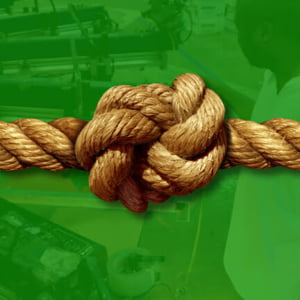One of the most frustrating things in the t-shirt business is explaining to a client why an order that was printed and shipped wasn’t as perfect as it could be. Every shop makes mistakes, no matter how many quality control steps and controls there are in place. The reason? It’s all centered on people doing the work, and people can lose focus. They can be distracted. Printing is a repetitive task. Sooner or later the focus is going to be less on what they are doing, and more on something else. Maybe they just aren’t right for the job? Here are some of the most common challenges, and a tidbit or two on how to correct them:
- Squares & Circles. The human eye naturally sees these and always knows what they should look like. Using too much spray tack, or carded water-based adhesive on the platens can lead to your press puller stretching the shirt when removing the shirt from the press. Instead of perfect squares or circles you get trapezoids and eggs. Sure, after washing, the shirt will go back to the original shape, but clients will reject these shirts if they see them. Be sure to spend time with your press crews and train them in the proper application of the adhesive, or look for low-tack versions of the product. If you do have some of these on the order, you can usually pull these back into shape with your hands by stretching the shirt fabric in opposite directions of the image distortion.
- Off-Centered & Crooked Printing. This is caused by either the press operator loading the shirt incorrectly, or your platens are not centered on the press arm of the press. Press loaders that concentrate their efforts on raising their daily production numbers are often guilty of loading the shirts incorrectly. Be sure that their speed matches their skill level in loading these correctly. The puller and catcher are responsible to check for this issue and inform the loader about the problem. If your platens aren’t all centered on the arm, your press operator or preventative maintenance tech should correct this issue. Don’t just put up with it!!
- Pinholes in the Print. This is where there is a small area or dot in the print that suddenly appears during the print run. More often than not this is caused from two sources. Lint or a stray thread from the shirt from the bottom of the screen is the most common. The other could be some debris from your environment, especially caused if your press has so much lint on it that it looks like a sheep that needs to be sheared. Keeping your printing environment clean can go a long way to minimize this issue. Your printing crews need to be on constant lookout for these challenges. A good catcher can pull these affected shirts to the side and often correct them by applying some ink to the shirt with a toothpick and then sending them back down the dryer. Don’t just reject them.
- Dots of Ink or Dirt on the Shirts. This is where a stray dot of ink or streak of dirt appears on the shirt. The ink issue is commonly caused by a breakdown in the emulsion on the screen, or from using film for exposing the image. Attention to detail in your screen reclaim area, and switching to a computer to screen imaging system can help prevent these issues. For the dirt challenge, make sure your shop carts and tables are kept clean and that your employees hands are clean as well. Please no food allowed in the production area. Explaining to a client why there’s a Cheetos stain on the corners of the shirt is a conversation you don’t want to have.
- Undercuring or Scorching Shirts. In the process, printing shirts use ink that all dry by heat. Controlling that heat is key to success. Most plastisol ink cures the moment it hits 320 degrees. It doesn’t need one degree more than that. Your preventative maintenance plan must include reviewing your dryer temperature often to ensure your dryer temps are where they need to be. Use test strips or a donut probe and keep a log weekly of the results for each dryer in your shop. Also review your flash cure units to ensure they are working properly, and adjust the temperature accordingly. During longer print runs these flash units can be adjusted as the platens will heat up with use. A way to test if your shirt is under-cured is to scratch the ink with your fingernail. If it is completely cured nothing will happen. You can also stretch the garment to see if the ink will crack. Some shirts, like the popular burnout style, are very prone to scorching. These are not only delicate, but usually more expensive than a normal blank. Take your time, and watch your heat. Your press crews are responsible for ensuring that the right techniques and controls are used for these jobs. This is all about training, but you need to have the expectation that they will handle these types of jobs correctly, every time.
- Using Heat Part 2 – Technical Fabrics. More and more popular these days is the prevalence of dri-fit, wicking and technical fabrics for production runs. Dye migration is most always caused by an excessive use of heat during the production process. Switch to a lower temp cure ink, and adjust your dryer temperature accordingly. Most of these ink systems cure at 280 degrees. Every time you heat the shirt, you are activating the dye in the shirt more and more. It’s a cumulative effect, so when your platens heat up, you flash the shirt with each color, and then send the shirt down the dryer you are adding to the problem with each step. Try to mitigate this problem by just doing enough with each step to proceed to the next, and by being careful. At the other end of the dryer, get air moving on the shirts by having a fan on the dryer belt and stacking the shirts in multiple piles on the catcher’s table, with fans blowing air on them constantly. The shirts have to be 100% cooled down before they go into a box. If you don’t control the built up heat in the shirt, what will happen is that the box will act like an oven and just continue to cook the shirts. This is why your client will report that some of the shirts have problems, but not all of them. It’s usually the ones in the middle of the stack in the box that have the issues. Using the right ink, controlling the heat during printing and drying, and cooling the shirts before packaging will eliminate your dye migration issues.
- Registration. Whole articles have been dedicated to this subject alone. I won’t get into everything here, but it’s your press crew’s responsibility to resolve these challenges and not accept or overlook these problems. There are a lot of variables that can affect your registration, and these include artwork, screen tension, press set-up, screen & platen leveling, and just plain ol’ crew skill level. If you are having registration issues, it is important to eliminate variables one step at a time. I usually start with the art first. Then screens, and then press issues. Eliminate them individually until you find the reason for the issue. However, none of this matters if your press crews just overlook the issues. Insist on excellence.
- Set-Up & Work Flow. How much you get printed in one day is completely linked to the dedication and hustle of your staff. Why didn’t that order ship on time? Could the reason be the people responsible for printing it? Can they read and understand the work order? Do they review the job details and discuss what has to happen before printing? Your staff’s attention to detail is what is going to separate you from the herd in your area. Hopefully, all the kinks have been worked out on the order before it gets to the production floor, but it’s their responsibility to review the order and see if they have the right shirts, screens, inks and that they are following the instruction as outlined on the work order. I’ve been to a lot of shops and seen press operators wandering around the production floor looking for their screens, a bucket of ink or a flood bar. If you make it easy for your press crews to get the job done, they shouldn’t have any reason to turn and burn more orders for you every day.
- Support Staff. Who is helping your staff achieve their daily goals? Are they doing a good job for you? Does the ink guy mix the right color and it is dead-on Pantone perfect? Is your art staff creating easy to print art, or do they use more colors for jobs just because you have more print heads available? Are they masters at creating underbase plates, or is there always a problem with how they choke something? How often do you reburn screens because they have to adjust halftones in the image? Are your managers quick to review jobs and approve, or do you waste a lot of time waiting to run an order because they can’t be found? Your press crews have to be the most vocal staff in the company about your challenges. Talk to them constantly. Are they getting everything they need to do their jobs quickly and professionally? Make sure they understand that they don’t have to “put up with something”. Work together to resolve your challenges. I’m not saying they should be screaming maniacs or throw people under the bus; but they should bring issues to your manager’s attention for resolution when they see something that isn’t right.
- Dependability. Is your staff dependable? Are they there for you every day, ready to work, and professional? This past year or two I have had many conversations with printers about their staff and how they can’t rely on their print crews. Some have attendance problems. Some lack good attitudes. Some just constantly have a hand out for more money without backing that up with performance. My advice? Find new people. Why put up with these issues if you don’t have to. The number one rule in managing people is to give clear expectations on how things should work, establish these as standards, and then adhere to them religiously. If you keep spending any amount of time talking or complaining about someone on your staff, document their behavior, reset the tone of what you need from them, and then if it doesn’t improve find someone new.
So, there is ten to start the conversation. Are there more examples for discussion? Certainly. What drives you bonkers? If you’d like to contribute to the discussion leave a comment or e-mail me at matkinson4804@gmail.com.





2 comments